MERCEDES-BENZ E-CLASS SALOON 2009 Owner's Guide
Manufacturer: MERCEDES-BENZ, Model Year: 2009, Model line: E-CLASS SALOON, Model: MERCEDES-BENZ E-CLASS SALOON 2009Pages: 373, PDF Size: 12.37 MB
Page 31 of 373
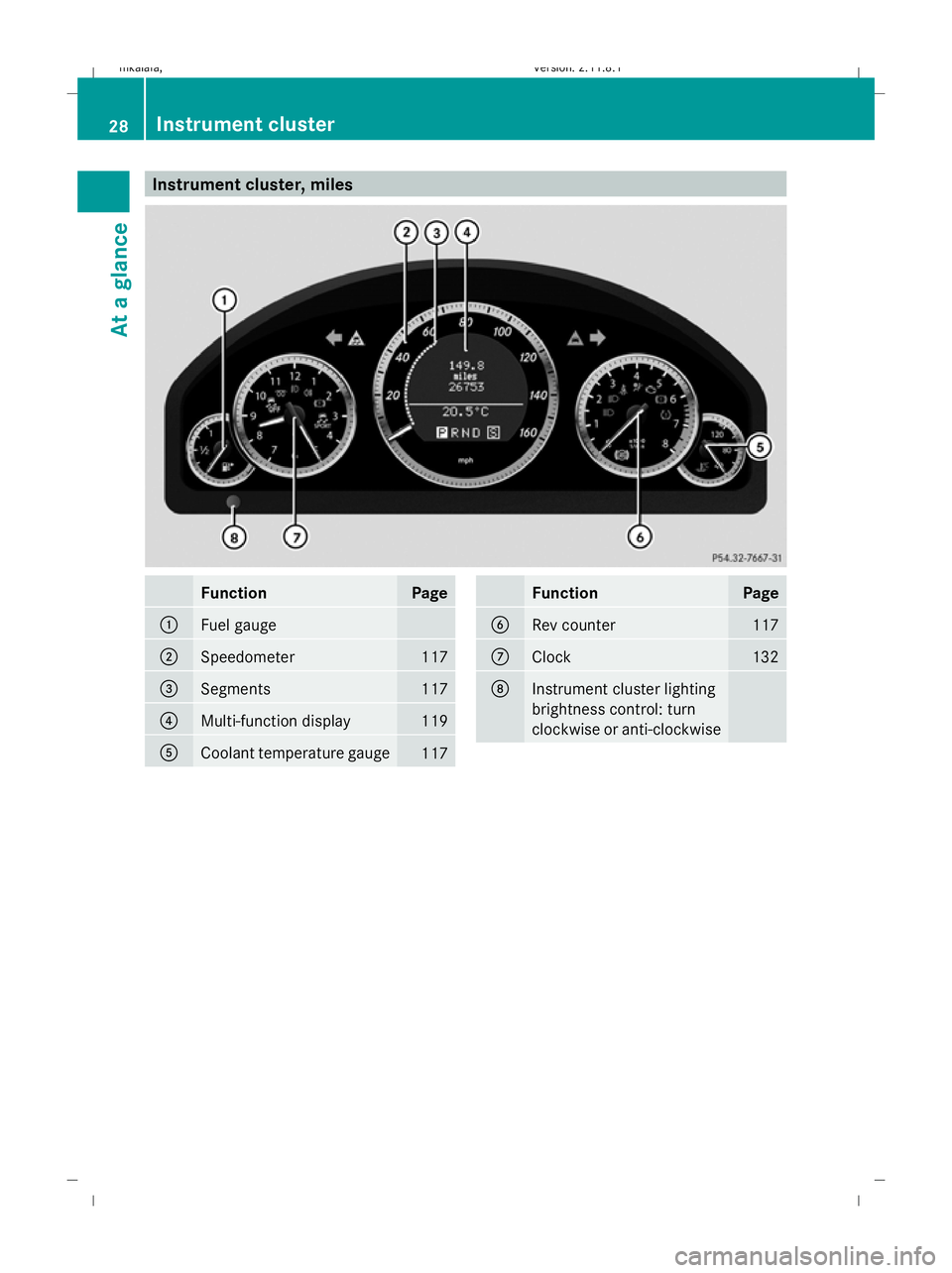
Instrument cluster, miles
Function Page
:
Fuel gauge
;
Speedometer 117
=
Segments 117
?
Multi-function display 119
A
Coolant temperature gauge
117 Function Page
B
Rev counter 117
C
Clock 132
D
Instrument cluster lighting
brightness control: turn
clockwise or anti-clockwise28
Instrument clusterAt a glance
212_AKB; 2; 4, en-GB
mkalafa,
Version: 2.11.8.1
2009-05-05T14:17:16+02:00 - Seite 28
Dateiname: 6515346702_buchblock.pdf; erzeugt am 07. May 2009 14:15:31; WK
Page 32 of 373
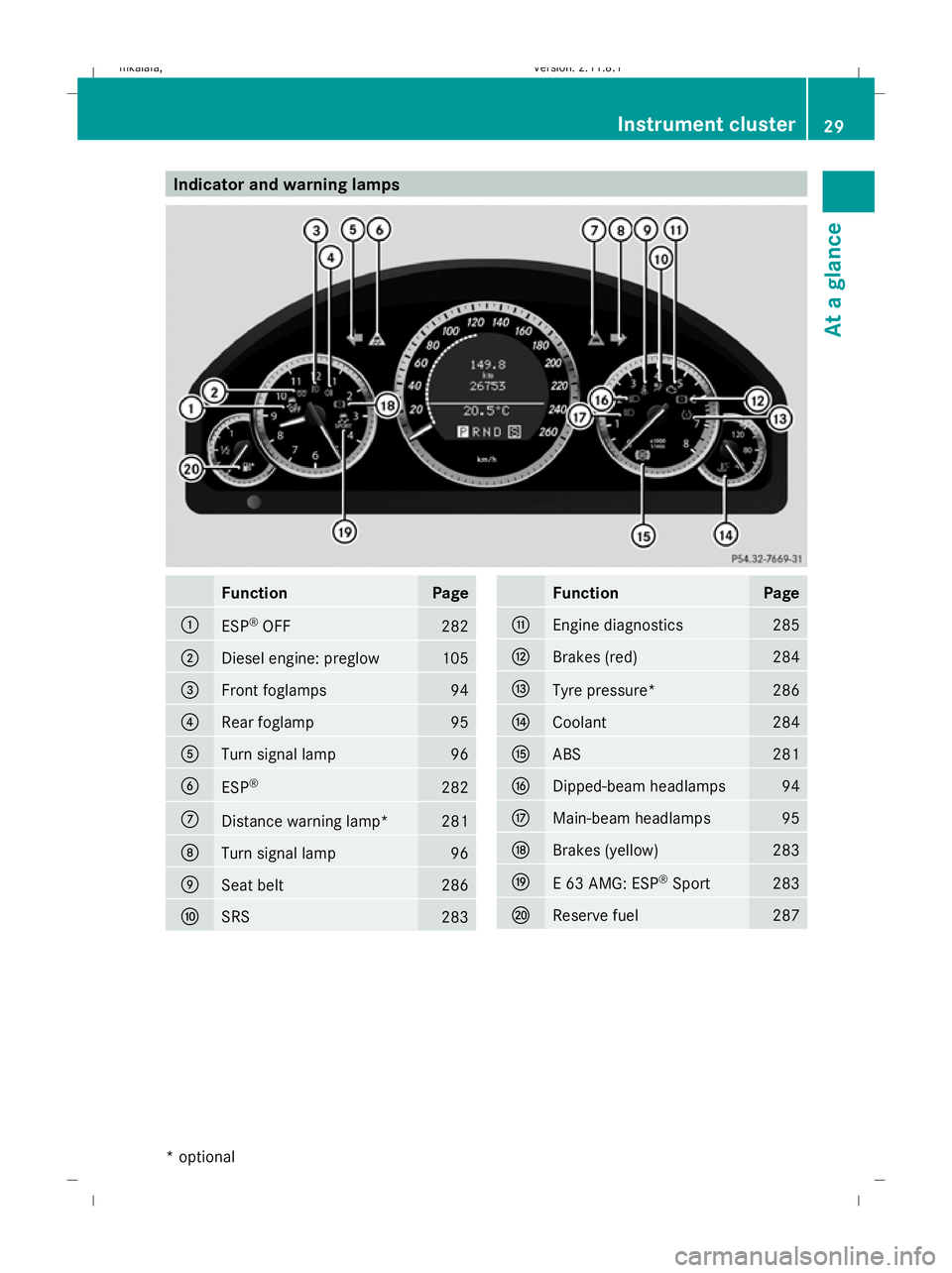
Indicator and warning lamps
Function Page
:
ESP
®
OFF 282
;
Diesel engine: preglow 105
=
Front foglamps 94
?
Rear foglamp 95
A
Turn signal lamp 96
B
ESP
® 282
C
Distance warning lamp* 281
D
Turn signal lamp 96
E
Seat belt 286
F
SRS
283 Function Page
G
Engine diagnostics 285
H
Brakes (red) 284
I
Tyre pressure* 286
J
Coolant 284
K
ABS 281
L
Dipped-beam headlamps 94
M
Main-beam headlamps 95
N
Brakes (yellow) 283
O
E 63 AMG: ESP
®
Sport 283
P
Reserve fuel 287Instrument cluster
29At a glance
* optional
212_AKB; 2; 4, en-GB
mkalafa,
Version: 2.11.8.1 2009-05-05T14:17:16+02:00 - Seite 29
Dateiname: 6515346702_buchblock.pdf; erzeugt am 07. May 2009 14:15:31; WK
Page 33 of 373
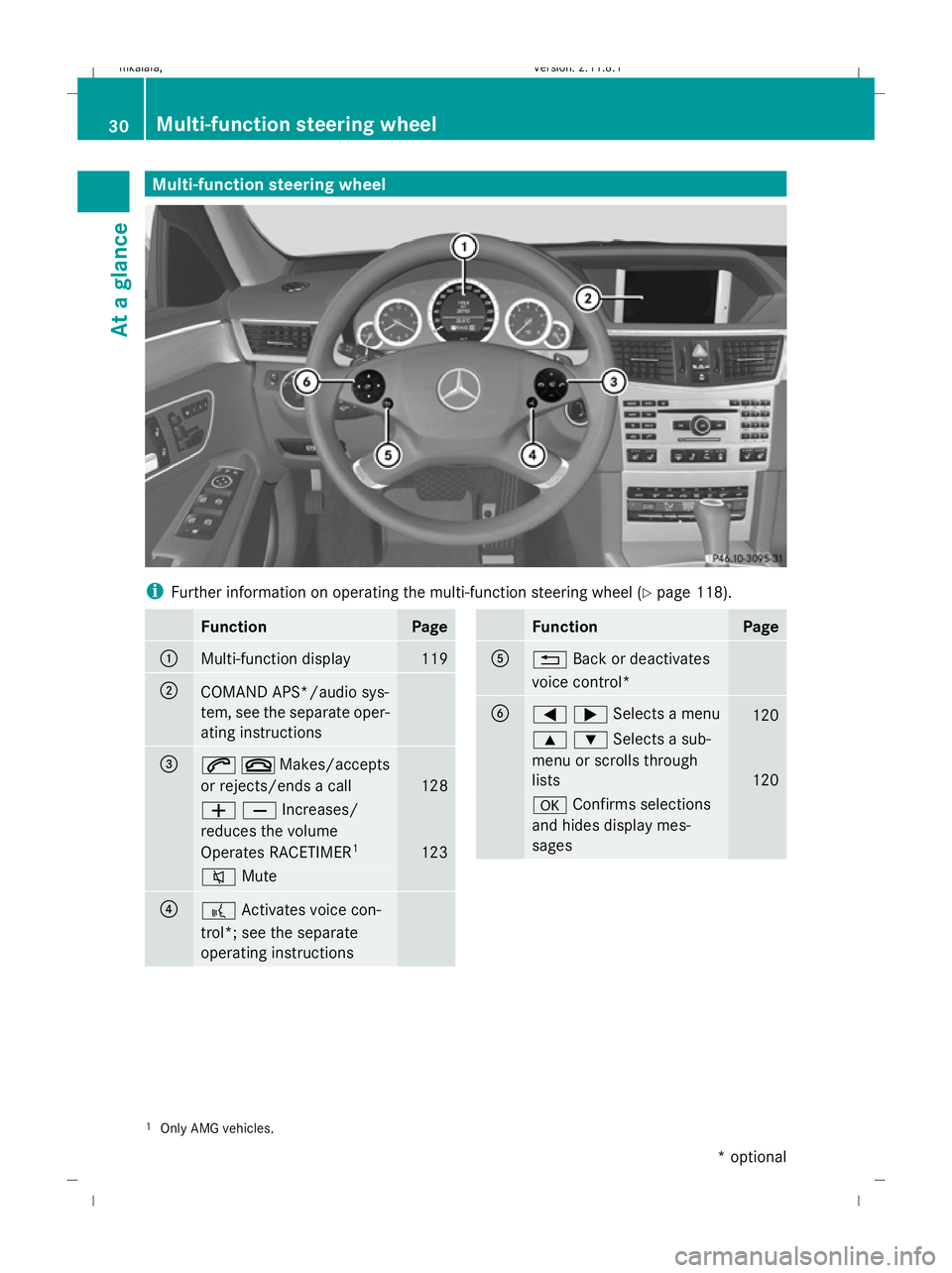
Multi-function steering wheel
i
Further information on operating the multi-function steering wheel (Y page 118).Function Page
:
Multi-function display 119
;
COMAND APS*/audio sys-
tem, see the separate oper-
ating instructions
=
6~Makes/accepts
or rejects/ends a call
128
WXIncreases/
reduces the volume
Operates RACETIMER
1 123
8
Mute ?
?
Activates voice con-
trol*; see the separate
operating instructions Function Page
A
%
Back or deactivates
voice control* B
=;Selects a menu
120
9:Selects a sub-
menu or scrolls through
lists
120
a
Confirms selections
and hides display mes-
sages 1
Only AMG vehicles. 30
Multi-function steering wheelAt a glance
* optional
212_AKB; 2; 4, en-GB
mkalafa
,V ersion: 2.11.8.1
2009-05-05T14:17:16+02:00 - Seite 30
Dateiname: 6515346702_buchblock.pdf; erzeugt am 07. May 2009 14:15:32; WK
Page 34 of 373
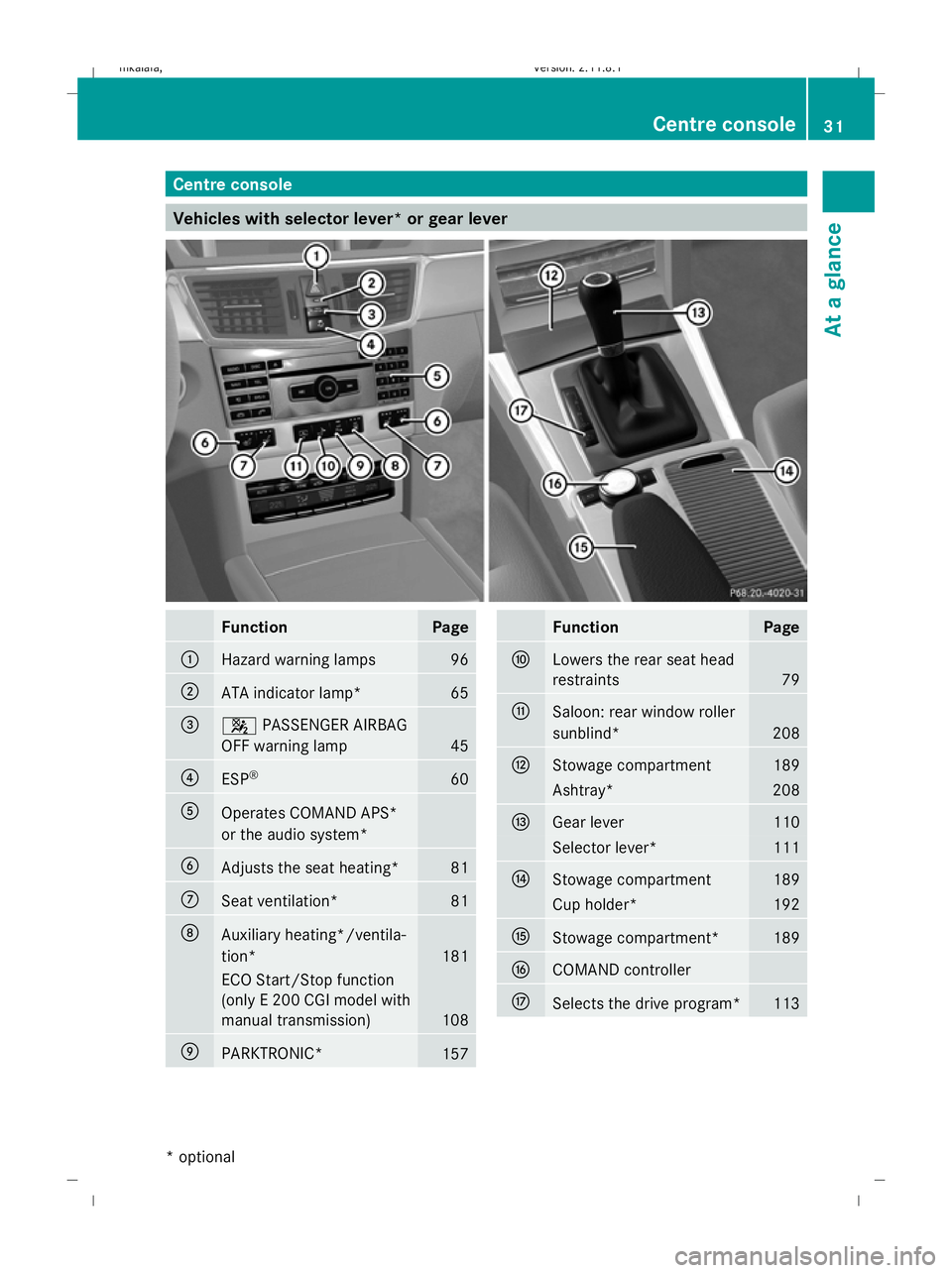
Centre console
Vehicles with selector lever
*or gear lever Function Page
:
Hazard warning lamps 96
;
ATA indicator lamp* 65
=
4
PASSENGER AIRBAG
OFF warning lamp 45
?
ESP
® 60
A
Operates COMAND APS*
or the audio system*
B
Adjusts the seat heating* 81
C
Seat ventilation* 81
D
Auxiliary heating
*/ventila-
tion* 181
ECO Start/Stop function
(only E 200 CGI model with
manual transmission)
108
E
PARKTRONIC*
157 Function Page
F
Lowers the rear seat head
restraints 79
G
Saloon: rear window roller
sunblind*
208
H
Stowage compartment 189
Ashtray* 208
I
Gear lever 110
Selector lever* 111
J
Stowage compartment 189
Cup holder* 192
K
Stowage compartment* 189
L
COMAND controller
M
Selects the drive program* 113Centre console
31At a glance
* optional
212_AKB; 2; 4, en-GB
mkalafa,
Version: 2.11.8.1 2009-05-05T14:17:16+02:00 - Seite 31 Z
Dateiname: 6515346702_buchblock.pdf; erzeugt am 07. May 2009 14:15:33; WK
Page 35 of 373
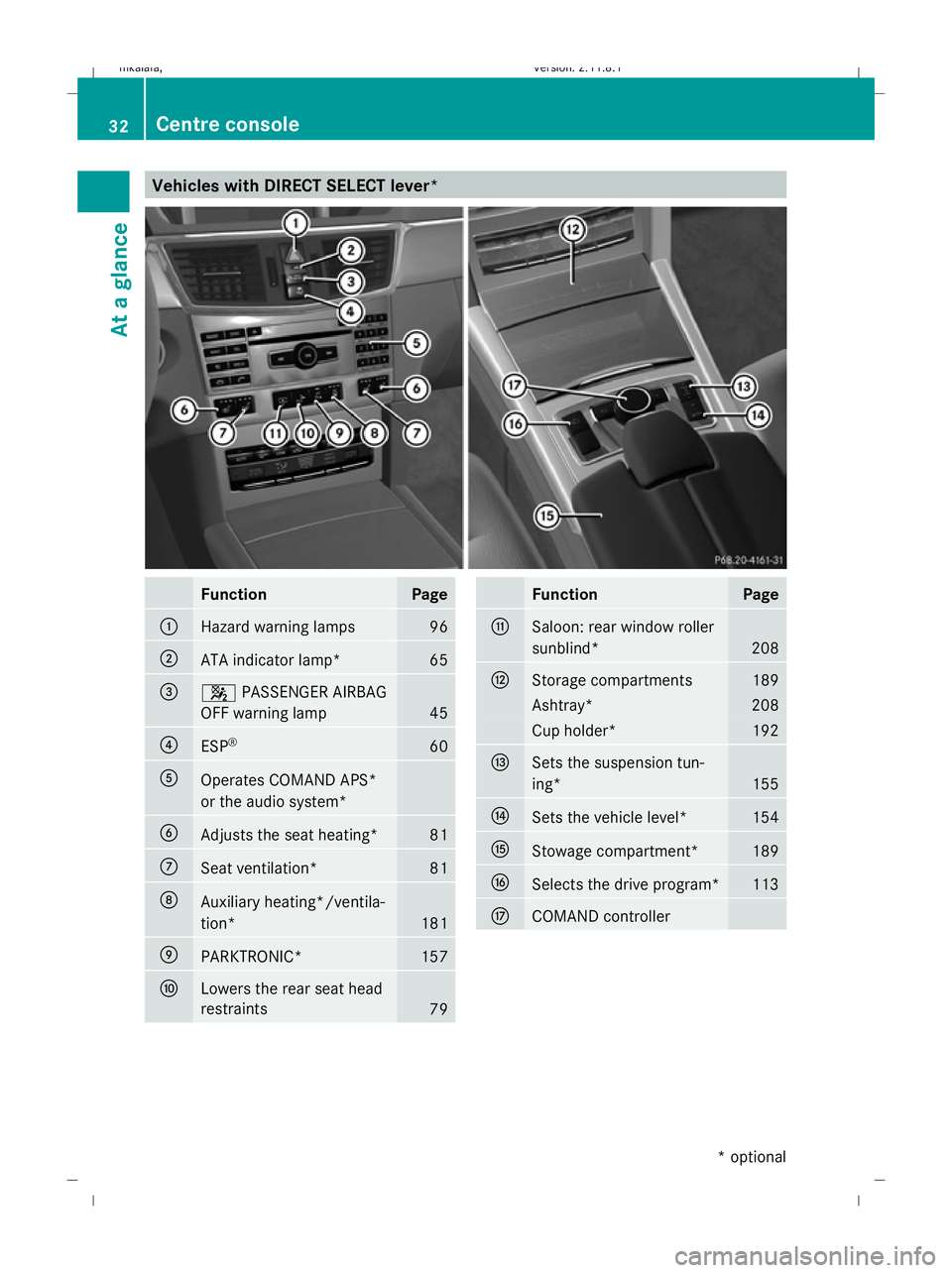
Vehicles with DIRECT SELECT lever*
Function Page
:
Hazard warning lamps 96
;
ATA indicator lamp* 65
=
4
PASSENGER AIRBAG
OFF warning lamp 45
?
ESP
® 60
A
Operates COMAND APS*
or the audio system*
B
Adjusts the seat heating* 81
C
Seat ventilation* 81
D
Auxiliary heating*/ventila-
tion*
181
E
PARKTRONIC* 157
F
Lowers the rear seat head
restraints
79 Function Page
G
Saloon: rear window roller
sunblind*
208
H
Storage compartments 189
Ashtray* 208
Cup holder* 192
I
Sets the suspension tun-
ing*
155
J
Sets the vehicle level* 154
K
Stowage compartment* 189
L
Selects the drive program* 113
M
COMAND controller32
Centre consoleAt a glance
* optional
212_AKB; 2; 4, en-GB
mkalafa,
Version: 2.11.8.1 2009-05-05T14:17:16+02:00 - Seite 32
Dateiname: 6515346702_buchblock.pdf; erzeugt am 07. May 2009 14:15:34; WK
Page 36 of 373
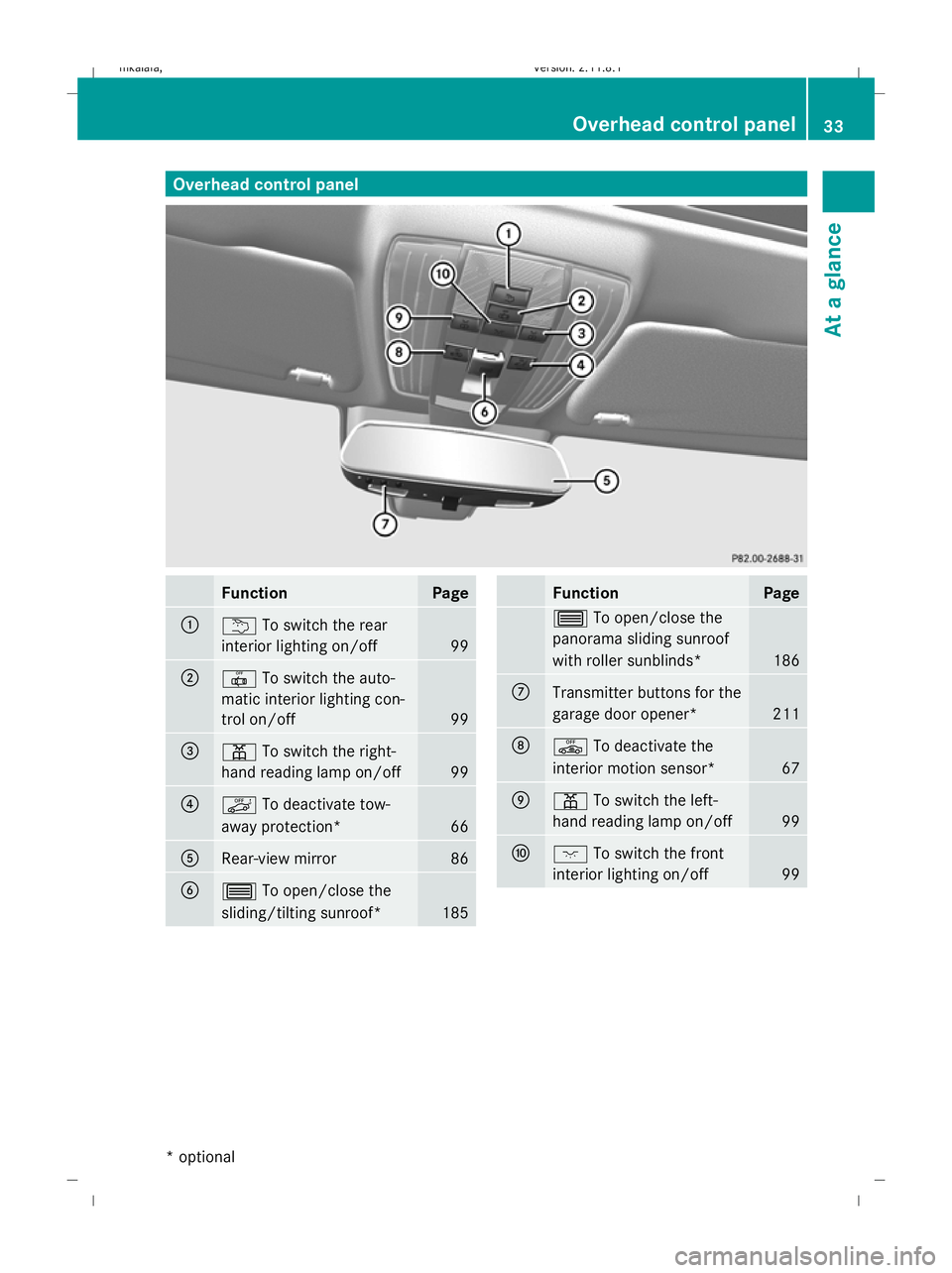
Overhead control panel
Function Page
:
u
To switch the rear
interior lighting on/off 99
;
|
To switch the auto-
matic interior lighting con-
trol on/off 99
=
p
To switch the right-
hand reading lamp on/off 99
?
ë
To deactivate tow-
away protection* 66
A
Rear-view mirror 86
B
3
To open/close the
sliding/tilting sunroof* 185 Function Page
3
To open/close the
panorama sliding sunroof
with roller sunblinds* 186
C
Transmitter buttons for the
garage door opener* 211
D
ê
To deactivate the
interior motion sensor* 67
E
p
To switch the left-
hand reading lamp on/off 99
F
c
To switch the front
interior lighting on/off 99Overhead control panel
33At a glance
* optional
212_AKB; 2; 4, en-GB
mkalafa,
Version: 2.11.8.1 2009-05-05T14:17:16+02:00 - Seite 33 Z
Dateiname: 6515346702_buchblock.pdf; erzeugt am 07. May 2009 14:15:34; WK
Page 37 of 373
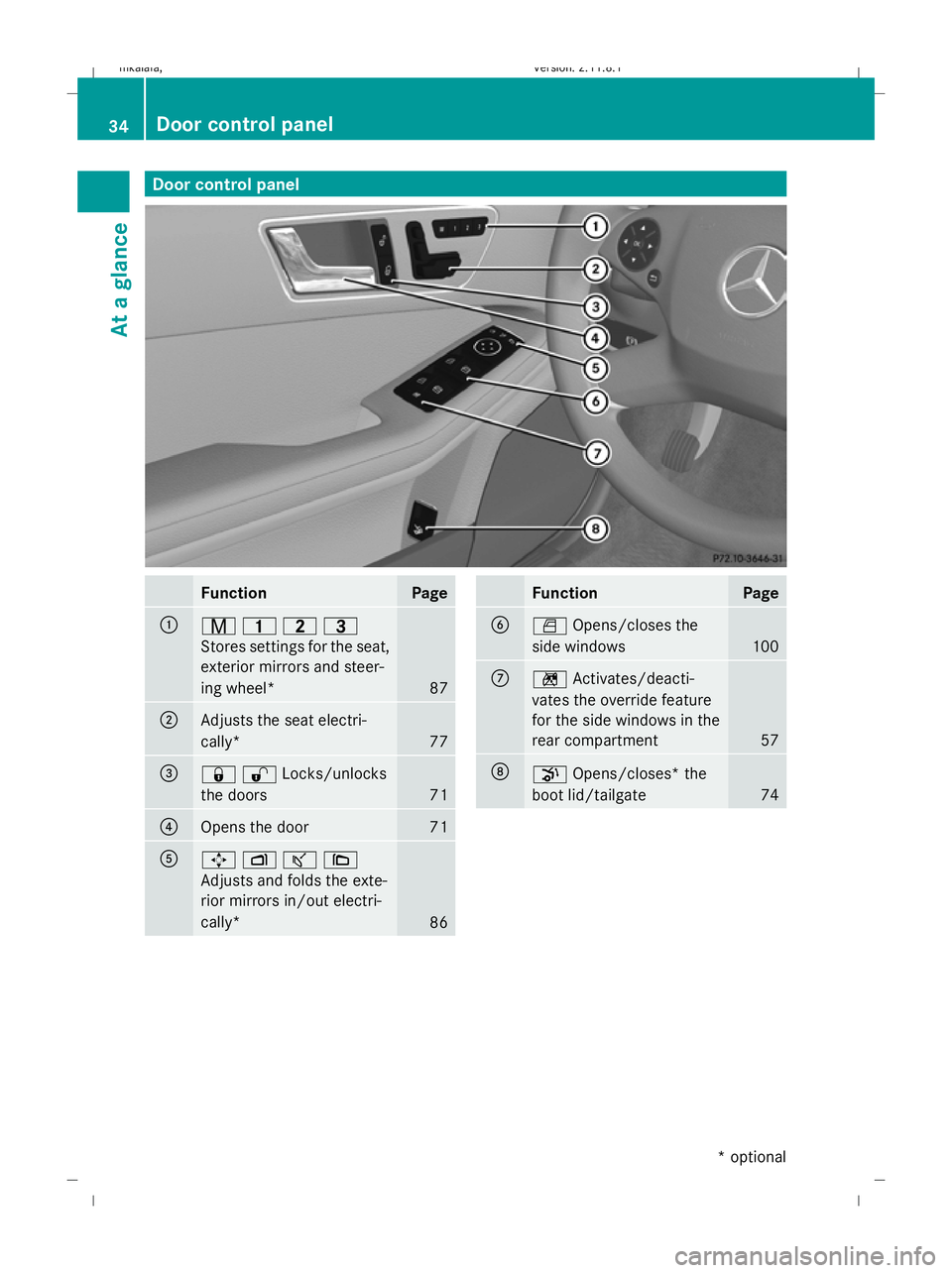
Door control panel
Function Page
:
r
45=
Stores settings for the seat,
exterior mirrors and steer-
ing wheel* 87
;
Adjusts the seat electri-
cally*
77
=
&%Locks/unlocks
the doors
71
?
Opens the door 71
A
7
Zª\
Adjusts and folds the exte-
rior mirrors in/out electri-
cally* 86 Function Page
B
W
Opens/closes the
side windows 100
C
n
Activates/deacti-
vates the override feature
for the side windows in the
rear compartment 57
D
p
Opens/closes* the
boot lid/tailgate 7434
Door control panelAt a glance
* optional
212_AKB; 2; 4, en-GB
mkalafa,
Version: 2.11.8.1 2009-05-05T14:17:16+02:00 - Seite 34
Dateiname: 6515346702_buchblock.pdf; erzeugt am 07. May 2009 14:15:35; WK
Page 38 of 373
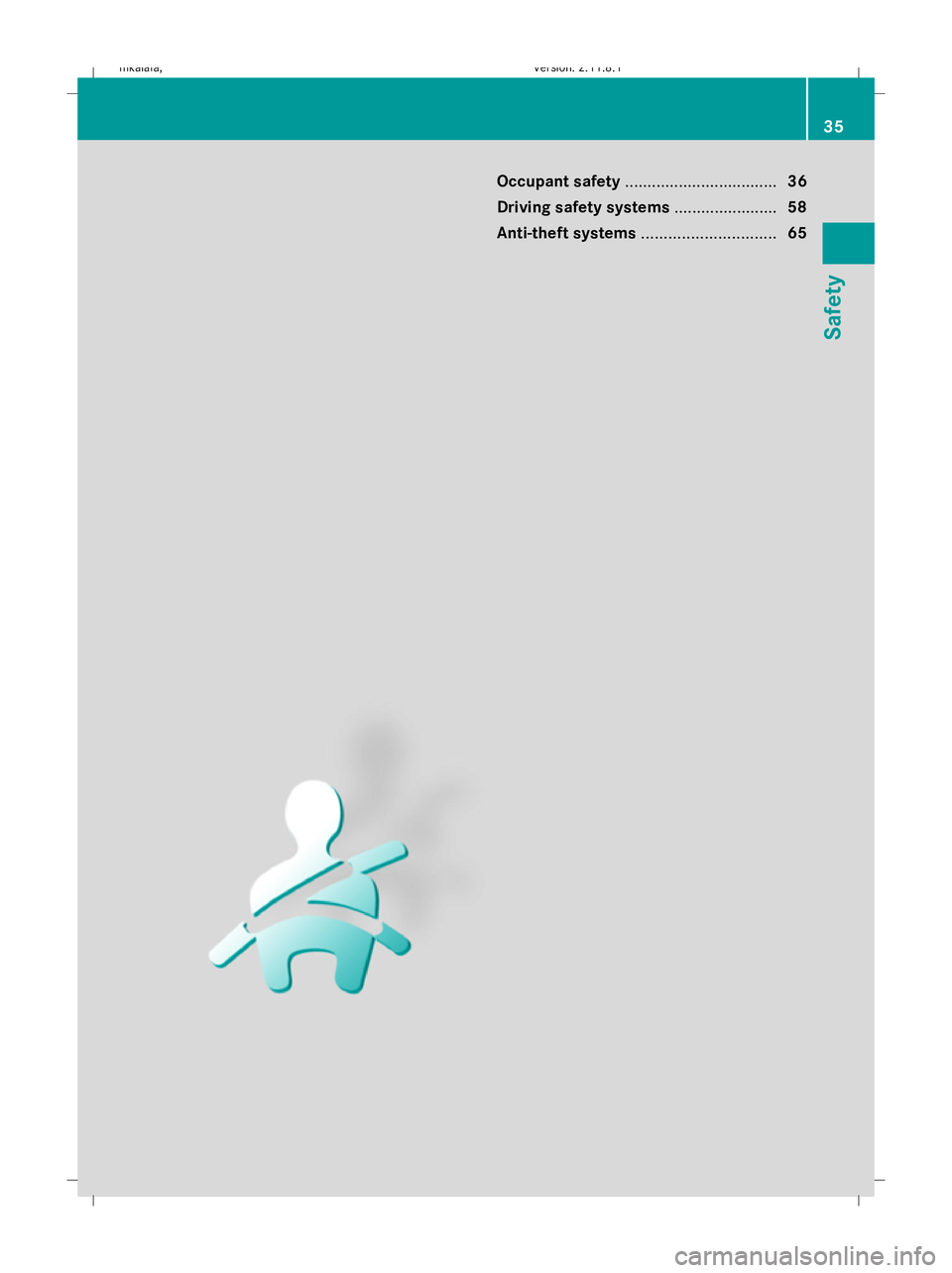
Occupant safety
.................................. 36
Driving safety systems .......................58
Anti-theft systems .............................. 65 35Safety
212_AKB; 2; 4, en-GB
mkalafa,
Version: 2.11.8.1 2009-05-05T14:17:16+02:00 - Seite 35
Dateiname: 6515346702_buchblock.pdf; erzeugt am 07. May 2009 14:15:36; WK
Page 39 of 373
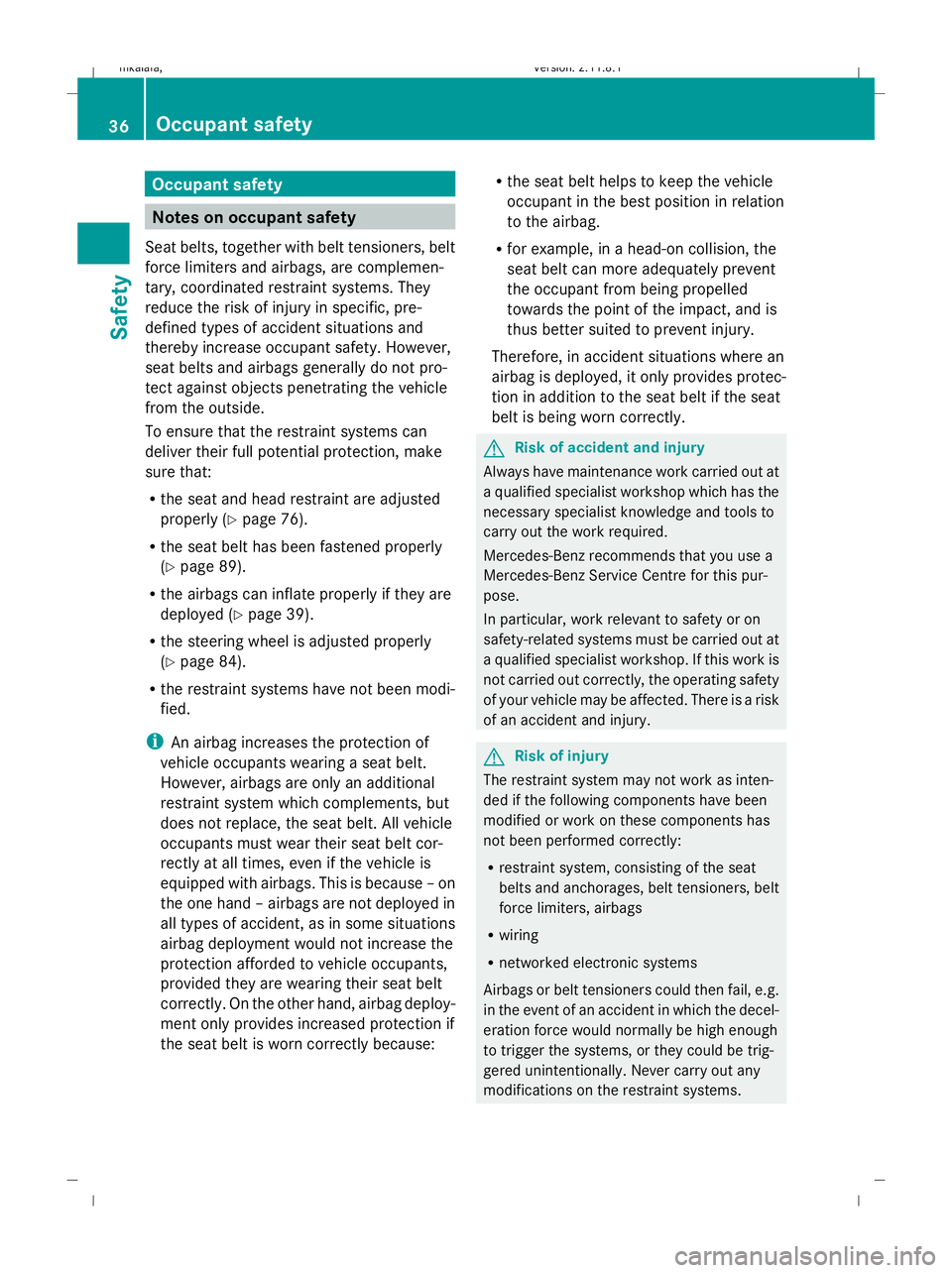
Occupant safety
Notes on occupant safety
Seat belts, together with belt tensioners, belt
force limiters and airbags, are complemen-
tary, coordinated restraint systems. They
reduce the risk of injury in specific, pre-
defined types of accident situations and
thereby increase occupant safety. However,
seat belts and airbags generally do not pro-
tect against objects penetrating the vehicle
from the outside.
To ensure that the restraint systems can
deliver their full potential protection, make
sure that:
R the seat and head restraint are adjusted
properly (Y page 76).
R the seat belt has been fastened properly
(Y page 89).
R the airbags can inflate properly if they are
deployed (Y page 39).
R the steering wheel is adjusted properly
(Y page 84).
R the restraint systems have not been modi-
fied.
i An airbag increases the protection of
vehicle occupants wearing a seat belt.
However, airbags are only an additional
restraint system which complements, but
does not replace, the seat belt. All vehicle
occupants must wear their seat belt cor-
rectly at all times, even if the vehicle is
equipped with airbags. This is because – on
the one hand – airbags are not deployed in
all types of accident, as in some situations
airbag deployment would not increase the
protection afforded to vehicle occupants,
provided they are wearing their seat belt
correctly. On the other hand, airbag deploy-
ment only provides increased protection if
the seat belt is worn correctly because: R
the seat belt helps to keep the vehicle
occupant in the best position in relation
to the airbag.
R for example, in a head-on collision, the
seat belt can more adequately prevent
the occupant from being propelled
towards the point of the impact, and is
thus better suited to prevent injury.
Therefore, in accident situations where an
airbag is deployed, it only provides protec-
tion in addition to the seat belt if the seat
belt is being worn correctly. G
Risk of accident and injury
Always have maintenance work carried out at
a qualified specialist workshop which has the
necessary specialist knowledge and tools to
carry out the work required.
Mercedes-Benz recommends that you use a
Mercedes-Benz Service Centre for this pur-
pose.
In particular, work relevant to safety or on
safety-related systems must be carried out at
a qualified specialist workshop. If this work is
not carried out correctly, the operating safety
of your vehicle may be affected. There is a risk
of an accident and injury. G
Risk of injury
The restraint system may not work as inten-
ded if the following components have been
modified or work on these components has
not been performed correctly:
R restraint system, consisting of the seat
belts and anchorages, belt tensioners, belt
force limiters, airbags
R wiring
R networked electronic systems
Airbags or belt tensioners could then fail, e.g.
in the event of an accident in which the decel-
eration force would normally be high enough
to trigger the systems, or they could be trig-
gered unintentionally. Never carry out any
modifications on the restraint systems. 36
Occupant safetySafety
212_AKB; 2; 4, en-GB
mkalafa,
Version: 2.11.8.1 2009-05-05T14:17:16+02:00 - Seite 36
Dateiname: 6515346702_buchblock.pdf; erzeugt am 07. May 2009 14:15:36; WK
Page 40 of 373
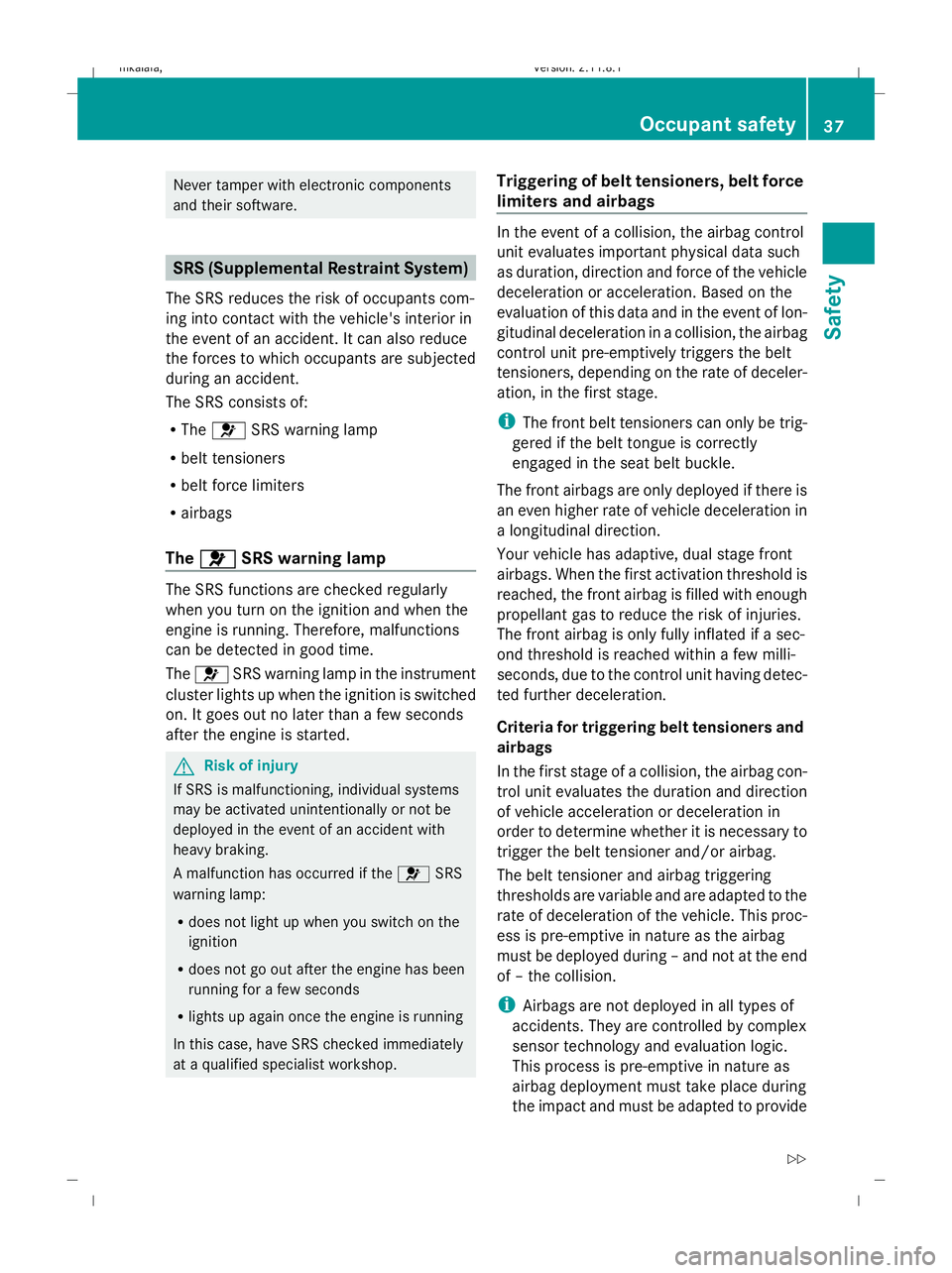
Never tamper with electronic components
and their software.
SRS (Supplemental Restraint System)
The SRS reduces the risk of occupants com-
ing into contact with the vehicle's interior in
the event of an accident. It can also reduce
the forces to which occupants are subjected
during an accident.
The SRS consists of:
R The 6 SRS warning lamp
R belt tensioners
R belt force limiters
R airbags
The 6 6 SRS warning lamp The SRS functions are checked regularly
when you turn on the ignition and when the
engine is running. Therefore, malfunctions
can be detected in good time.
The
6 SRS warning lamp in the instrument
cluster lights up when the ignition is switched
on. It goes out no later than a few seconds
after the engine is started. G
Risk of injury
If SRS is malfunctioning, individual systems
may be activated unintentionally or not be
deployed in the event of an accident with
heavy braking.
A malfunction has occurred if the 6SRS
warning lamp:
R does not light up when you switch on the
ignition
R does not go out after the engine has been
running for a few seconds
R lights up again once the engine is running
In this case, have SRS checked immediately
at a qualified specialist workshop. Triggering of belt tensioners, belt force
limiters and airbags In the event of a collision, the airbag control
unit evaluates important physical data such
as duration, direction and force of the vehicle
deceleration or acceleration. Based on the
evaluation of this data and in the event of lon-
gitudinal deceleration in a collision, the airbag
control unit pre-emptively triggers the belt
tensioners, depending on the rate of deceler-
ation, in the first stage.
i
The front belt tensioners can only be trig-
gered if the belt tongue is correctly
engaged in the seat belt buckle.
The front airbags are only deployed if there is
an even higher rate of vehicle deceleration in
a longitudinal direction.
Your vehicle has adaptive, dual stage front
airbags. When the first activation threshold is
reached, the front airbag is filled with enough
propellant gas to reduce the risk of injuries.
The front airbag is only fully inflated if a sec-
ond threshold is reached within a few milli-
seconds, due to the control unit having detec-
ted further deceleration.
Criteria for triggering belt tensioners and
airbags
In the first stage of a collision, the airbag con-
trol unit evaluates the duration and direction
of vehicle acceleration or deceleration in
order to determine whether it is necessary to
trigger the belt tensioner and/or airbag.
The belt tensioner and airbag triggering
thresholds are variable and are adapted to the
rate of deceleration of the vehicle. This proc-
ess is pre-emptive in nature as the airbag
must be deployed during – and not at the end
of – the collision.
i Airbags are not deployed in all types of
accidents. They are controlled by complex
sensor technology and evaluation logic.
This process is pre-emptive in nature as
airbag deployment must take place during
the impact and must be adapted to provide Occupant safety
37Safety
212_AKB; 2; 4, en-GB
mkalafa, Version: 2.11.8.1 2009-05-05T14:17:16+02:00 - Seite 37 Z
Dateiname: 6515346702_buchblock.pdf; erzeugt am 07. May 2009 14:15:36; WK